This is the communications ‘Word of the Year,’ according to you
When we asked the Ragan community to vote on the word of the year, the most popular choice wasn’t a word at all.

In early December, during Ragan Communications Leadership Council’s retreat at the Ritz Carlton in Laguna Niguel, California, council members shared their picks for the communications “Word of the Year”. As members voted from their mobile devices, a word cloud began to populate on screen. “Burnout” was a clear winner, with other words and phrases close behind.
Last week, we shared a LinkedIn poll to see how the wider Ragan community would rank the choices. 790 of you voted in a close race that saw a clear winner.
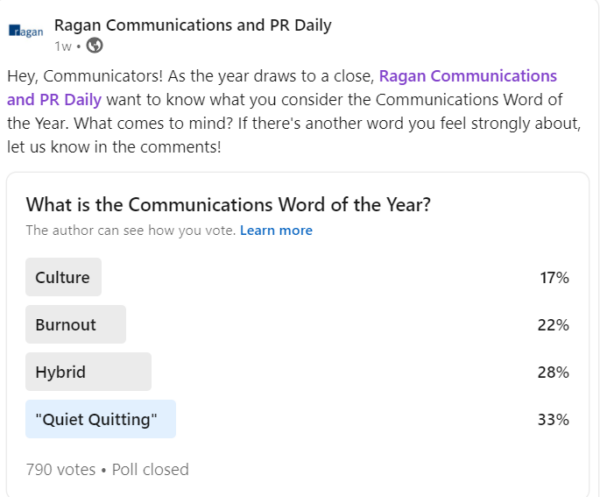
We know, we know, “quiet quitting” is not a single word. In that respect, “Word of the Year” seems like a bit of a misnomer. But then again, “quiet quitting” is a misnomer on its own — a phrase that doesn’t accurately portray the phenomenon it refers to.
The phrase, which became popular as a TikTok trend, refers to a phenomenon wherein employees only fulfill the bare minimum of their job expectations, not pushing themselves to work extra hours or take on additional responsibilities.
A controversial winner
Though “quiet quitting” clearly won out, much of the phrase’s popularity in comms circles can be attributed to the fact that several communicators take issue with its meaning and relevance. Upon the publication of this poll, one commented that the phrase has no utility beyond a TikTok trend and fodder for think pieces, while another said that the phrase has been deployed by people who only make “a half-assed effort.”
While this perspective is echoed by several senior comms leaders in the Ragan community, it also emphasizes the fact that your employees are rethinking what constitutes reasonable effort and sufficient productivity in their roles.
“Employees aren’t ‘quiet quitting,’” Omnicom Chief Equity and Impact Officer Emily Graham told me earlier this year. “They’re sending you the message every day.”
Nothing new, but the stakes have changed
Of course, the “quiet quitting” phenomenon is nothing new — workers have been passively resigning to do the bare minimum since the dawn of capitalism. What’s changed, however, is what work looks like in a changed world.
While the pandemic literally brought work home, remote and hybrid employees are challenged to set stricter boundaries and guardrails to protect themselves from leaders who don’t model a healthy work/life balance. Add to that the fact that the early months of the pandemic shattered the sense of security that many felt, making mortality and questions of existential purpose top of mind for many who have never considered such heady, lofty matters before. Suddenly, in the scheme of things, appeasing a boss didn’t matter as much. If those leaders didn’t adjust their communications styles and up the empathy ante, doubly so.
The Wall Street Journal explained quiet quitting in the early days of the phrase, citing a Gallup poll that found employee engagement was at record lows:
Across generations, U.S. employee engagement is falling, according to survey data from Gallup, but Gen Z and younger millennials, born in 1989 and after, reported the lowest engagement of all during the first quarter at 31%.
Jim Harter, chief scientist for Gallup’s workplace and well-being research, said workers’ descriptions of “quiet quitting” align with a large group of survey respondents that he classifies as “not engaged”—those who will show up to work and do the minimum required but not much else. More than half of workers surveyed by Gallup who were born after 1989—54%—fall into this category.
One factor Gallup uses to measure engagement is whether people feel their work has purpose. Younger employees report that they don’t feel that way, the data show. These are the people who are more likely to work passively and look out for themselves over their employers, Dr. Harter said.
What can you do?
Though it’s tempting to write this phenomenon off as a viral trend or laziness by another name, this impulse is reductive and — depending on your role within the organization — may be perceived as classist. It also emphasizes the split in perspectives on who should be primarily responsible for protecting employee engagement.
While some senior leaders cite their frustration with people managers and poor manager comms as the reason for declining employee engagement, others acknowledge that this change starts at the top with leaders. The leaders who own this are modeling proper behavior for engagement and communication, working consciously to connect corporate purpose and employee purpose with each message they send, and staying open to feedback while acting on it at every opportunity.
To that end, here are some steps communicators can take to effectively acknowledge and address the ‘quiet quitting’ phenomenon at work.
- Understand that it’s not all created equal. With any trend comes a danger in lumping all examples of the trend together. When it comes to quiet quittin’, however, you should remember that there are different types of quiet quitters. How you bring a burnt out employee back into the fold may be different from how you work with one who is simply misaligned with expectations, or another who is detached from your company’s larger purpose. Training managers and leaders to ask questions that tease out these nuances is the first step toward addressing the core issue.
- Acknowledge the ripple effect. This phenomenon trended for a reason. Recent research suggests that quiet quitting doesn’t just effect one person, as it can result in extra work for the employees who remain engaged and sour manager relationships with their detached direct reports at a time when the support is most needed.
- Encourage leaders to move past blame and focus on solutions. The leaders who stop putting the onus on disconnected employees to change and learn to look within will start to see results, executive coach Ken Jacobs wrote for Ragan. Jacobs offers tips for listening to affected employees, asking the right questions, inspiring them and determining their level of motivation. He also encourages leaders to delegate and empower their employees.
Love it or hate it, quiet quitting was here to stay in 2022. The good news is that it doesn’t have to be the norm headed into the new year. Start with a strategic diagnosis of each employee’s engagement that looks beyond their productivity to look at why they’re pulling away. Bring these results to leaders and remind them of their role in modeling the change they want to see. Your workforce will thank you.
Justin Joffe is the Editor-in-chief at Ragan Communications where he oversees the editorial strategy for Ragan.com and the Communications Leadership Council. You can find him on Twitter @joffaloff.


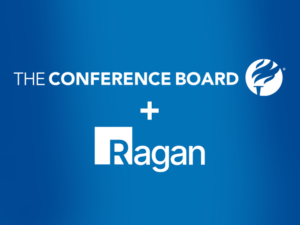
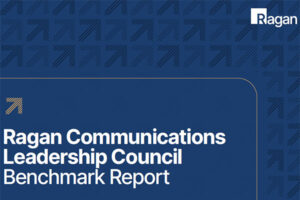
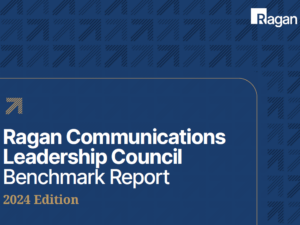
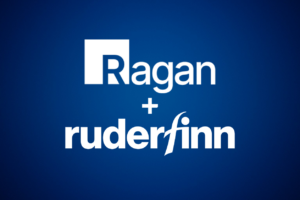

It is an interesting piece. In the organizations that have been involved in recognizing its issues in my country, the Sultanate of Oman (in the Middle East), I have been observing this occurrence. I mistakenly believed that this phenomena only concerned the country because of the swift changes in the structure of government, but the underlying causes are very similar to those I outlined in the essay. This makes sense to me.
Thank you!